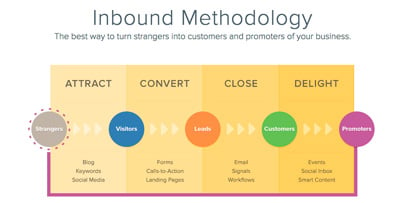The landscape of marketing among manufacturing companies is changing. If your company is still relying solely on outbound marketing (traditional advertising) by using print ads, trade shows, telemarketing and other costly tactics to generate new business by pushing messages outward – you are sure to experience something our partners at HubSpot call the “Oh S**T” Moment.
 This is the moment when you realize that it is not only people looking for a Black Friday deal, a new phone or an electronic item that use Google for their search. Did you know that over 90% of B2B buyers (including those researching new manufacturing equipment and services) start their research online? If your potential customers can’t find you, they may find your competitor. And there is that moment…
This is the moment when you realize that it is not only people looking for a Black Friday deal, a new phone or an electronic item that use Google for their search. Did you know that over 90% of B2B buyers (including those researching new manufacturing equipment and services) start their research online? If your potential customers can’t find you, they may find your competitor. And there is that moment…
1. Must-Haves for Successful Inbound Marketing
If you are new to inbound marketing, it may seem daunting to take the step to convert your marketing strategies. Getting started could be the biggest hurdle that you will have to jump. The first step is having a basic understanding of the must-have components of your inbound marketing program. Consider the following:
- Web Content and Blog: There is a certain amount of engineering that if done effectively, will set you apart from your competitors and boost the likelihood that your site will be found first. By pairing a strong keyword strategy with dynamic copywriting in addition to frequently updated blog posts, your site will position your business as the leader in your area of expertise.
Quick Takeaway: Identify your most important product and services pages and comb through them to find opportunities to add: answers to the most pressing questions prospective customers may have; internal links, for more in-depth information on your brand; and lastly, text and image calls-to-action -- what do you want visitors to do next? Want to learn more? Check out: Manufacturers’ 4 Step Guide to Producing Content for Effective Channels - Fostering Collaboration between Marketing & Sales: It is important to establish a communication process between sales and marketing and help them align in order to continually move in the right direction. Each should be clear of their role in the inbound marketing strategy to successfully generate and convert leads.
Quick Takeaway: Create a master calendar or idea board that identifies marketing, website and sales priorities, and clearly defines ownership of task completion. If you have a set goal and work collectively towards it with clear, defined direction, you’re more likely to see success. - Landing Pages & Calls To Action: As you drive visitors to your website, you need a technique to convert the visitor to a lead. Creating a landing page as a place to capture contact information is a highly-effective tool to provide the necessary information for following up with a prospect. Not sure where to start? The free Essential Elements of High Converting Landing Pages ebook will help you optimize your landing pages to increase conversion rate and ultimately generate more customers.
Quick Takeaway: Never let a prospect leave your page without asking them to take some type of action. Whether it’s an image or text based CTA in your pages, or a leadflow that pops up and makes them an offer they just can’t refuse -- always make an effort to turn prospects into leads. Want to learn more? Check out: Secrets To Creating A Lead-Generating EBook For Manufacturers
- Social Media: Social media is an important factor in your digital marketing plan for a couple of reasons. First, it allows you to expand on positioning your business and staff as experts in your industry by sharing relevant information and content that is posted on your website. By sharing that content, it drives traffic to your website, providing more opportunities for lead conversion. It also acts as a platform to listen to relevant conversations about your products and services and interact with potential, current or new customers.
Quick Takeaway: Using only a few dollars a day, incorporating paid social with highly targeted audiences can help you hit the right people, with the right message. Facebook and LinkedIn, for example, offer detailed targeting opportunities that can target by geography, interests and job title. Video is a fantastic medium to highlight B2B and B2C manufacturers and can make a huge impact with only a few ad dollars. - Analytics: Accountability and return on investment are trackable with a few key tools to review analytics. The great part about using analytics tools is that a number of them are free such as keyword graders, sources of traffic, social media reach and lead generation conversion metrics.
Quick Takeaway: Developing a monthly marketing analytics dashboard is the best way to track your data regularly and to use data strategically to drive your next marketing initiatives. Using a tool like Databox makes it easy to add dashboards and track your website, social channels, video, search and more.
2. How To Get Found, First
We mentioned above how strong web content, keyword incorporation, SEO optimization and frequent blogging plays a role in ranking high and being found when potential leads search for products and services online. It is important that we stress how imperative it is that you show up on the first page of search engine rankings. The reason for this is the first 10 results on the page get 90% of the click-thrus and of these, the first three get the most clicks. Building your site incorporating inbound marketing practices will allow you to be a lead generating superstar within your industry.
Quick Takeaway: Start local. Update your Google and directory listings and ask delighted customers for Google Reviews. Then, take a deep dive into your analytics and identify which keywords you want to be found for and start sprinkling them into your website content. Write blogs, adjust some phrasing on your website and get in the conversation around the key terms that will drive prospects to your pages.
3. Lead Generation
Engineered in the most effective way and partnered with a strong inbound marketing plan, your website can be a lead generating machine. Part of your plan should include lead generation campaigns – a series of integrated strategies and tactics built around an offer that brings prospects to a landing page on your website where you collect the visitor’s contact information. The best lead generating campaigns include ways to promote a special offer both on your website and other vehicles including social media, pay-per-click advertising, e-newsletters and more. View the beginners guide to lead generation here.
Quick Takeaway: Add site retargeting when you implement you lead generation campaign. Site retargeting involves using social media, and a plethora of other platforms, to serve up ads to people who have recently visited your website. You’ve likely seen this when you leave an item in your cart on a website, and suddenly it’s popping up everywhere for your buy! Whether it’s a favorite online newspaper, magazine, shopping site or blog, prospective customers who didn’t convert into leads the first time, will see your ads and have the opportunity to click back to your website. Retargeting allows your brand to stay top of mind and drive visitors back to your offer.
4. Nurturing
Have you experienced a situation where you’ve asked for more information or provided your contact information to a business, and never received a follow up? Missed opportunity on their part, right? Nurturing a lead is a critical part of inbound marketing strategies (especially for manufacturing companies), because if you have a long sales cycle, prospects should receive communication over a period of time in order to convert the lead into a client. Nurturing can be done through marketing technology such as an automated series of emails allowing you to stay top of mind. Keep messaging around thought leadership (information the prospect will be interested in learning and which positions you as an expert – think educational, promotional, best practice sharing) and not just sales. Try to target messaging as specific to the lead as possible.
Quick Takeaway: Consider how you can incorporate personalization into your nurturing campaigns to make your readers feel unique and truly special. With platforms like Hubspot, you can add personalization tokens and specific data details into your email campaigns, making it easy to tailor your messages to your prospects on an individual level. Now that’s customer service.
5. Tidal Wave
Manufacturing companies are realizing the value of inbound marketing versus traditional methods of advertising and promoting their business. Through the ability to be found, generate leads and position their business and employees as experts – the methods discussed in this post have the potential to deliver increased ROI.
Will your inbound marketing plan be ahead of your competitors in the next few years? By creating content specifically designed to appeal to your dream customers, inbound attracts qualified prospects to your business and keeps them coming back for more.
Looking to learn more about how to use inbound marketing to transform the way you market your products and services? You’re one click away from the path to bigger, better and faster growth of your top line.





